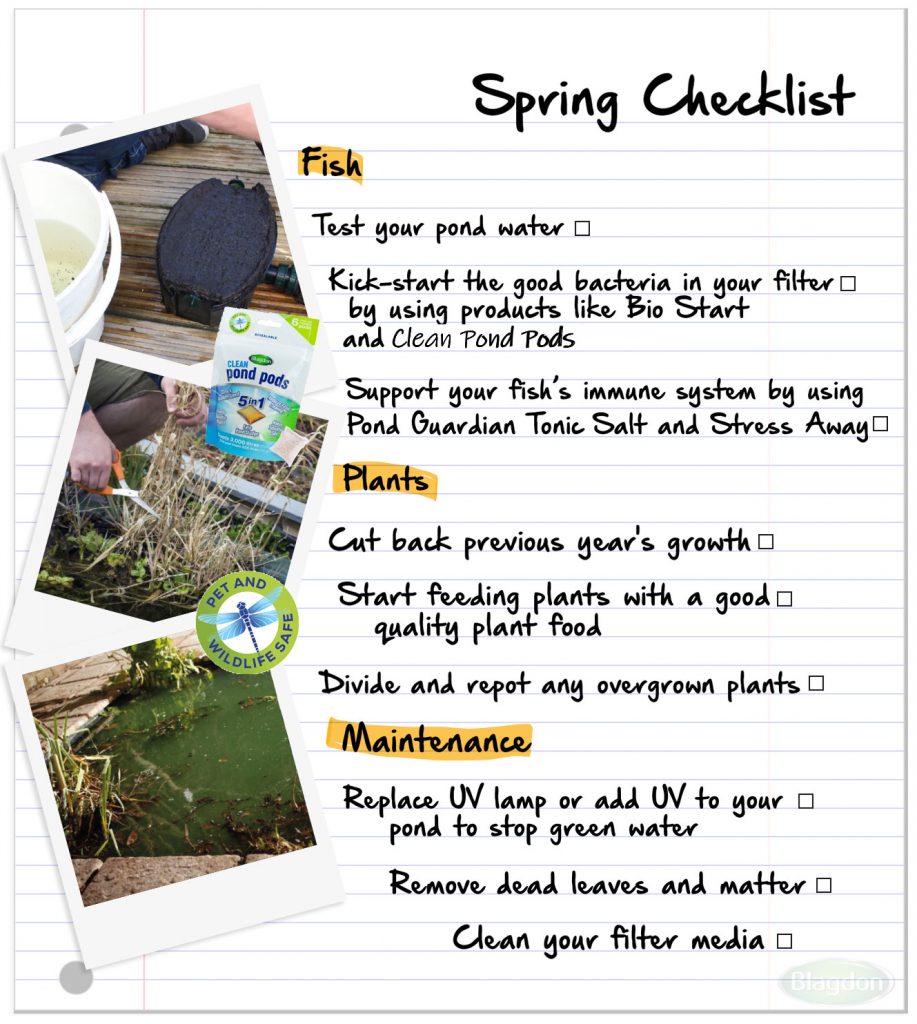Spring Pond Maintenance
Spring is the time where your pond comes back to life after the dormancy of the winter months. Not only is your pond enjoying the warmer weather, but it is likely that you are too, so starting to make sure your pond is looking beautiful and healthy is important when you start spending more time in the garden.

Your fish will begin to become more active as temperatures begin to rise. After the relative hibernation of winter, fish can become weakened and it is important to support them by supplying the best possible water conditions. Start by reigniting the effectiveness of your biological filter by using products that host good bacteria and enzyme cultures like Bio Start or multi functional Clean Pond Pods.
We would also suggest using a treatment of Stress Away and adding Pond Guardian Pond Salt to support your fish’s immune system as disease organism populations can respond more quickly than the fish to increasing water temperatures. If you notice any abnormal fish behaviour such as clamped fins, flicking or symptoms of disease, treat the problem promptly but also test your water to see if there is an underlying water quality issue and use our Diagnose What’s Wrong tool to help with solutions.
As the pond temperatures begin to rise over 10oc you can start feeding your fish regularly again with good quality and easily digestible pond food. It can be hard to work out how much food your fish need, as a guideline give them as much as they can eat in about 5 minutes. If food is remaining after 5-10 minutes, remove it from the pond with a net.
Cut back the previous year’s growth early in March/April when new growth begins to appear. Start feeding them with a good quality plant food, this is especially important for successful water lilies.
Plant foods like Flora Boost are specially formulated as low nitrate and low phosphate which will encourage healthy plant growth but limit algae blooms and green water problems. Alternatively, regular use of Clean Pond Pods will not only feed your plants but help with varying algal and dirt issues, and will make tap water safe when using a hose.
Spring is also the time to introduce new plants to the pond, as this will give them time to establish in time for summer. Divide and re pot overgrown marginal plants to encourage variety and seasonal interest.
The increase in light and nutrients in your pond in Spring can often lead to an algae bloom or green water problems. Now is a good time to replace your UV lamp or add a UV to your pond to eliminate green water issues.
Ensure all dead leaves and plant matter is removed as the rising temperature will speed up their decay. Thoroughly clean your biological filter media in pond water and rinse or replace mechanical media such as: polymer wool and open cell foam.
During the winter, your liner may have suffered from wear and tear due to freezing temperatures or from plant growth. Inspect your pond liner for any signs of damage or leaks as you prepare you get your pond going again. Look for cracks, tears, or punctures that may have happened over the winter months. If you do notice any issues, try to patch them with a suitable repair kit.
You’ll also want to clean the liner to remove algae buildup and any debris that has settled. Use a soft brush or sponge to gently scrub the surfaces, being careful not to damage the liner.
For future protection, consider using a cover net to prevent any damage to your pond liner.
After cleaning your water, use a pond water testing kit to monitor pH, ammonia, nitrite, and nitrate levels. Ideal conditions for pond water typically include a pH of 6.5 to 8.5, mimicking natural pH levels found in freshwater habitats, and low levels of ammonia and nitrite. Biological activity tends to increase in spring, so keep an eye on these factors.
If any of these parameters are off, make necessary adjustments through partial water changes or by using appropriate treatments. Remember to use a dechlorinator when adding new water to ensure the safety of your fish and plants.
Before you start up your pond again, check that your pond pump is working as it should be. Over the winter it may have become blocked with debris or experienced wear and tear from previous use. If you notice any broken parts, make sure they are fixed or replaced to ensure your pump works correctly.
Once everything is working properly, start the pump gradually to avoid shocking your fish with sudden changes in water movement. This will help reacclimate them to their environment as circulation returns to normal.
